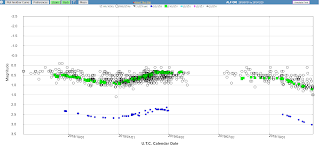Friday, December 20, 2019
Betelgeuse Fades More
Evening sky looking north-east at 23:00 ACDST on Saturday December 21. Similar views will be seen elsewhere in Australia at the equivalent local time. Orion is readily visible.
Betelgeuse is the bright red star below the "saucepan" of Orion. Red Aldebaran is almost the same height above the horizon as red Betelgeuse, making comparison easy. Aldebaran is magnitude 0.85 and is now visibly brighter than Betelgeuse.
Betelgeuse is a red giant star which forms a distinctive part of the Constellation of Orion the Hunter.
While familiar to almost all casual observers of the night sky, not may people know Betelgeuse is a variable star, with small fluctuations in brightness not visible to the casual observer. It typically ranges between 0.3 to 1.0 (in the stellar magnitude system smaller numbers are brighter than larger numbers). For a fuller explanation of Belegueses complex variability see my previous post.
 A 2 year light curve of Betelgeuse from the light curve generator at the AAVSO. It's a bit messy because of all the observations , but if you pick out the yellow line you can see that it has now dipped to around magnitude 1.5 in the latest observations.
A 2 year light curve of Betelgeuse from the light curve generator at the AAVSO. It's a bit messy because of all the observations , but if you pick out the yellow line you can see that it has now dipped to around magnitude 1.5 in the latest observations.
It your sky is not covered by smoke of cloud at the moment go out now (well, its best to go out around 11:00 pm when the reference stars are high enough. for good comparisons. The Moon is not in the evening sky to interfere with the stars brightness. Nearby Aldebaran (magnitude 0.85) also red, is a good comparison star. Belatrix, the other shoulder star of Orion opposite Betelgueuses is magnitude 1.6. The middle star of Orions belt, Alnilam is magnitude 1.7 and Adhara in Canis Major is Magnitude 1.5. Achernar (magnitude 0.45), Alpha Crucis (magnitude 0.61) Mimosa (beta crucis magnitude ) and Beta Centauri (magnitude 0.55) are also good comparison stars but further away and harder to compare (see chart below).
Star Map via Virtual sky. Use your mouse to scroll around and press 8 when your pointer is in the map to set to current time.
Cloud cover predictions can be found at SkippySky.
Here is the near-real time satellite view of the clouds (day and night) http://satview.bom.gov.au/
Betelgeuse is the bright red star below the "saucepan" of Orion. Red Aldebaran is almost the same height above the horizon as red Betelgeuse, making comparison easy. Aldebaran is magnitude 0.85 and is now visibly brighter than Betelgeuse.
Betelgeuse is a red giant star which forms a distinctive part of the Constellation of Orion the Hunter.
While familiar to almost all casual observers of the night sky, not may people know Betelgeuse is a variable star, with small fluctuations in brightness not visible to the casual observer. It typically ranges between 0.3 to 1.0 (in the stellar magnitude system smaller numbers are brighter than larger numbers). For a fuller explanation of Belegueses complex variability see my previous post.
 A 2 year light curve of Betelgeuse from the light curve generator at the AAVSO. It's a bit messy because of all the observations , but if you pick out the yellow line you can see that it has now dipped to around magnitude 1.5 in the latest observations.
A 2 year light curve of Betelgeuse from the light curve generator at the AAVSO. It's a bit messy because of all the observations , but if you pick out the yellow line you can see that it has now dipped to around magnitude 1.5 in the latest observations.It your sky is not covered by smoke of cloud at the moment go out now (well, its best to go out around 11:00 pm when the reference stars are high enough. for good comparisons. The Moon is not in the evening sky to interfere with the stars brightness. Nearby Aldebaran (magnitude 0.85) also red, is a good comparison star. Belatrix, the other shoulder star of Orion opposite Betelgueuses is magnitude 1.6. The middle star of Orions belt, Alnilam is magnitude 1.7 and Adhara in Canis Major is Magnitude 1.5. Achernar (magnitude 0.45), Alpha Crucis (magnitude 0.61) Mimosa (beta crucis magnitude ) and Beta Centauri (magnitude 0.55) are also good comparison stars but further away and harder to compare (see chart below).
Star Map via Virtual sky. Use your mouse to scroll around and press 8 when your pointer is in the map to set to current time.
Cloud cover predictions can be found at SkippySky.
Here is the near-real time satellite view of the clouds (day and night) http://satview.bom.gov.au/
Labels: Betelgeuse, unaided eye, variable star




 Click to read about or order
Click to read about or order Click to read about or order
Click to read about or order Click to read about or order
Click to read about or order Click to read about or order
Click to read about or order




